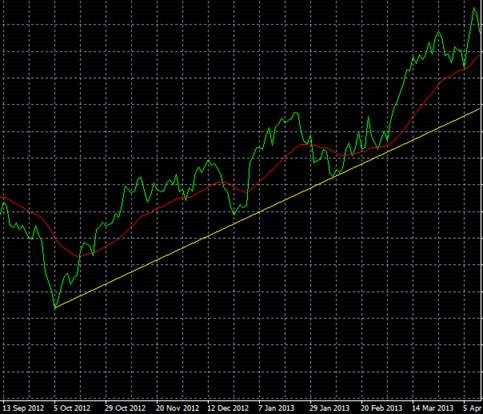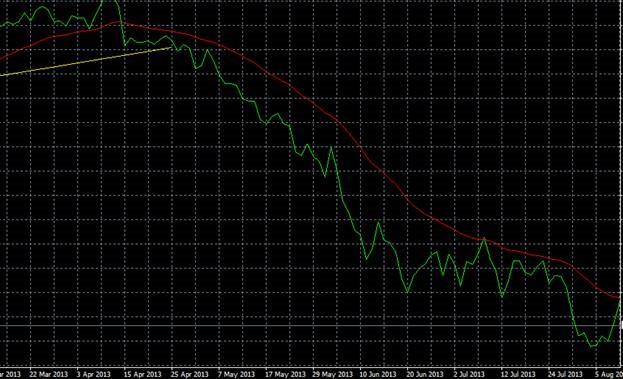Using a Currency Basket to Trade Forex Sentiment
Updated: 2017-10-09 10:13:29Introduction
If we can correctly gauge sentiment we can predict which way a currency is likely to move … in the direction of the underlying sentiment. The problem is in a currency pair there is another currency in which to analyze the sentiment. This complicates things as it doubles the sentiment analysis which we much do. Additionally sentiment is the same for both currencies, the currency pair may be in a trading range.
For example, if we analyzed AUD sentiment as strongly negative, but also determined that USD sentiment was negative, the AUDUSD pair may be ranging instead of trending. A solution to this is to construct a currency basket which will track a currency index, and then trade the entire basket in the direction of sentiment.
This article will first use a basket of currencies to construct a currency index to see how the currency moves against other pairs which it trades against, then will use a linear regression model to determine the weightings of each currency pair in the basket to replicate the index. Next we will use the index and sentiment analysis in an example to enter and exit a trade based upon sentiment analysis.
The below example will demonstrate this method on AUD, but can be extended to work on any other currency (USD, GBP, EUR, CAD, CHF, JPY, and NZD).
AUD Currency Index
We will take the major pairs which AUD trades against to construct an ‘AUD index’:
· AUDCAD
· AUDCHF
· AUDJPY
· AUDNZD
· AUDUSD
· EURAUD
· GBPAUD
Daily closing data from 1/4/2010 to 2/18/2013 was used (814 data points) to create the AUDindex by calculating the percent change from each pair from the start of the data set:
AUDindex(i) 
This AUDindex isolates the effect of AUD on the pairs which it trades against, so can model the AUD movement as a whole against all pairs. The above formula gives the average % move against all AUD pairs (as referenced from the first data point).
AUD Currency Basket
To model the AUD index we don’t take exactly the same ratio of all currency pairs, but instead conduct a linear regression to model AUDindex against the other pairs to determine the weightings of each pair:

A summary of the linear regression yields the following results:
| Coefficients: | |||||||
| Estimate Std. Error t value Pr(>|t|) | |||||||
| (Intercept) -4.286e-01 1.286e-09 -333267393 <2e-16 *** | |||||||
| AUDCAD 1.503e-01 7.317e-10 205457407 <2e-16 *** | |||||||
| AUDCHF 1.521e-01 4.094e-10 371454621 <2e-16 *** | |||||||
| AUDJPY 1.692e-03 3.801e-12 445214275 <2e-16 *** | |||||||
| AUDNZD 1.151e-01 4.055e-10 283804631 <2e-16 *** | |||||||
| AUDUSD 1.566e-01 7.190e-10 217796418 <2e-16 *** | |||||||
| EURAUD -9.050e-02 3.061e-10 -295669918 <2e-16 *** | |||||||
| GBPAUD -8.109e-02 4.325e-10 -187483633 <2e-16 *** | |||||||
| --- | |||||||
| Signif. codes: 0 ‘***’ 0.001 ‘**’ 0.01 ‘*’ 0.05 ‘.’ 0.1 ‘ ’ 1 | |||||||
| Residual standard error: 2.82e-10 on 806 degrees of freedom | |||||||
| Multiple R-squared: 1, Adjusted R-squared: 1 | |||||||
| F-statistic: 1.911e+18 on 7 and 806 DF, p-value: < 2.2e-16 | |||||||
This is an excellent linear model due to the very low p-values for each coefficient (close to 0). We are interested in the coefficients of the model:
| AUDCAD | 0.1503 |
| AUDCHF | 0.1521 |
| AUDJPY | 0.1692 |
| AUDNZD | 0.1151 |
| AUDUSD | 0.1566 |
| EURAUD | -0.0905 |
| GBPAUD | -0.0810 |
AUDJPY was adjusted by a factor of 100 to scale it, since AUDJPY trades at xx.xx, while the other pairs trade as x.xxxx.
We can create the AUD basket by taking the appropriate ratio of number of units of each currency pair. This can be done exactly on a broker such as Oanda, since can trade an exact number of units. Other brokers would need to be rounded to the nearest number of mini lots:

A comparison of the predicted linear regression model and original basket yields a similar plot.
AUD sentiment analysis basket trading example
All subsequent graphs in this article are of the AUD basket on a daily chart.
April 10, 2013: AUD Employment change forecast to be -6.7k, actual -36.1k (huge miss). AUD index fell from high, but still above recent trendline (yellow) and 25 day ema of the close (red line).
We watch price action for the next couple of days till the end of the week, and see that on Friday April 12th the AUD basket closed off of its high:

With such a huge miss on an important piece of fundamental data, a short AUD position could be established here with a plan to exit on close above recent highs. To be conservative we will wait for more fundamental data to confirm negative sentiment, along with price action.
April 14, 2013: Chinese GDP misses (7.7% vs. 8% expected), and the AUD basket and all AUD crosses look weak against the AUD. We will open an AUD short at the open on the 15th using the AUD basket ratios, with a manual SL to exit the basket if the basket closes above and makes a recent high above the April 10th highs.
April 15, 2013: A short is established against the AUD basket at the open on April 15th. To determine the initial lot sizes, we need to first determine the initial risk (based upon the SL of the recent highs of the basket). We see that the recent April 10th highs of the AUD basket are approximately 2% above current levels.
For the currency basket SL calculation, we make the assumption that each pair will move 2% against the AUD … when in actuality some pairs will move more/less against AUD. The purpose of the SL calculation is used to calculate the initial lots for each pair … these are not hard SL levels. The SL is when the currency index basket has a daily close above a certain level (in this case above the April 10th highs).
If we want to risk 5% on this basket trade, and have a $10k act balance (risking $500), the lot size calculation is as follows:
| Position | Pair | Weight | Price | Units | SL | PL 1 pip | P/L |
| Short | AUDCAD | 0.1503 | 1.0648 | 17141.77 | 1.0435 | 1.6285 | -89.3663 |
| Short | AUDCHF | 0.1521 | 0.9735 | 17347.06 | 0.9540 | 1.8735 | -96.3917 |
| Short | AUDJPY | 0.1692 | 103.19 | 19297.32 | 101.1200 | 1.9490 | -131.73 |
| Short | AUDNZD | 0.1151 | 1.2223 | 13127.2 | 1.1979 | 1.0239 | -37.7489 |
| Short | AUDUSD | 0.1566 | 1.0504 | 17860.29 | 1.0294 | 1.7860 | -104.903 |
| Long | EURAUD | -0.0905 | 1.2478 | -10321.6 | 1.2728 | 0.9289 | -21.6931 |
| Long | GBPAUD | -0.081 | 1.4595 | -9238.08 | 1.4887 | 0.8314 | -18.1666 |
| Total | -500 |
Pair = currency pair
Weight = weighting from linear regression
Price = April 15th opening price
Units = Weight * notional lot size (determined as described below)
SL = 2% SL for AUD loss determined as 2% from initial entry price.
PL 1 pip = Profit for 1 pip move for pair for # of Units
P/L = Loss if SL hit (again, not actual SL, but if basket AUD basket moved 2% against initial positions, and this move was equally distributed against all pairs).
The total P/L (-$500) is used with Microsoft Excel solver to solve via the Generalized Reduced Gradient (GRG) Nonlinear method notional lot size. This is in turn used to compute the number of units for each pair (as per the coefficients from the linear regression model).
Over the next few weeks, both AUD and CNY data tend to overall disappoint, and the AUD basket is now in a downtrend and below its 25 day EMA. On May 8th, there is good data for AUD (Employment change 50.1k vs. 11.5k expected), but AUD closed near its low for the day:

With such good fundamental news and AUD closing near its lows for the day, sentiment is clearly negative. This is an excellent place to add to our AUD short basket. For purposes of this article, we will just monitor the initial AUD short basket position.
Fundamental data continues to be negative for both AUD and CNY, but when it is good the AUD basket does not positively react to the news (at least not for long). This continues for months … additionally, if we monitor weekly Commitment of Traders (COT) report data for futures, we see that the net non commercial position (funds) are increasing shorts, while the commercials (hedgers) are increasing longs almost every week. This is the sign of a strong down trend.
August 7, 2013: AUD employment change is -10.2k (6.2k expected), and the CNY trade balance was 17.8B (26.2B expected). Huge misses for both, but the AUD basket does not make new lows:

With so many funds short (from COT), and with now new lows being made, we “metagame” and think what would these funds do??? Likely be worried, and possibly start to cover short future positions. We decide to possibly exit to bank profits, but wait to see what the next day brings for fundamental data.
August 8, 2013: RBA monetary policy statement, and CNY CPI is 2.7% (expected 2.8%), and the AUD basket closes up, with all crosses closing strong against the AUD. We close all positions at the 8/8 close with the following results:
| Position | Pair | Weight | Price | Units | TP | PL 1 pip | P/L |
| Short | AUDCAD | 0.1503 | 1.0648 | 17148.54 | 0.9399 | 1.6291 | 524.4441 |
| Short | AUDCHF | 0.1521 | 0.9735 | 17353.91 | 0.8480 | 1.8742 | 620.8566 |
| Short | AUDJPY | 0.1692 | 103.19 | 19304.94 | 88.0300 | 1.9498 | 965.5124 |
| Short | AUDNZD | 0.1151 | 1.2223 | 13132.38 | 1.1355 | 1.0243 | 134.393 |
| Short | AUDUSD | 0.1566 | 1.0504 | 17867.34 | 0.9104 | 1.7867 | 699.9057 |
| Long | EURAUD | 0.0905 | 1.2478 | 10325.6 | 1.4693 | 0.9293 | 192.3527 |
| Long | GBPAUD | 0.081 | 1.4595 | 9241.73 | 1.7059 | 0.8318 | 153.4173 |
| Total | 3290.882 |
Note: Units and PL for 1 pip are slightly different, due to the way I set up the Excel spreadsheet for the calculations. Overall, the P/L is more or less accurate, and our basket netted almost 33% return in a few months.
Overall this article is mean to show that you can use a currency basket to trade sentiment … this is especially useful if you don’t know or can’t gauge the sentiment of other currencies. Additionally, sometimes sentiment can cause currencies to trend for weeks on end, and it can be easier to analyze a basket of currencies, rather than many pairs!
